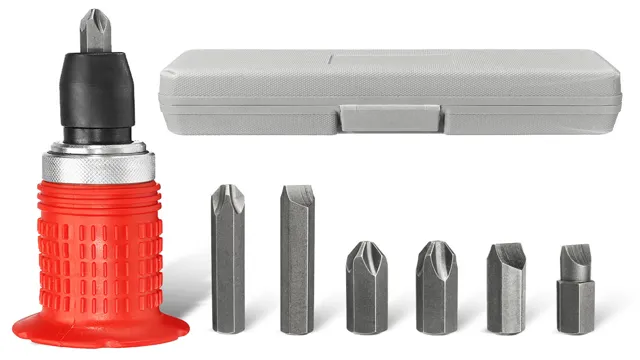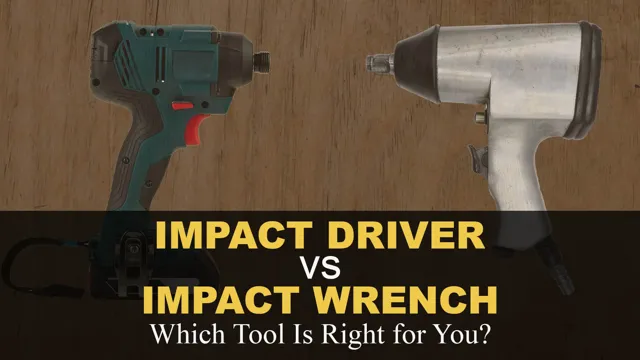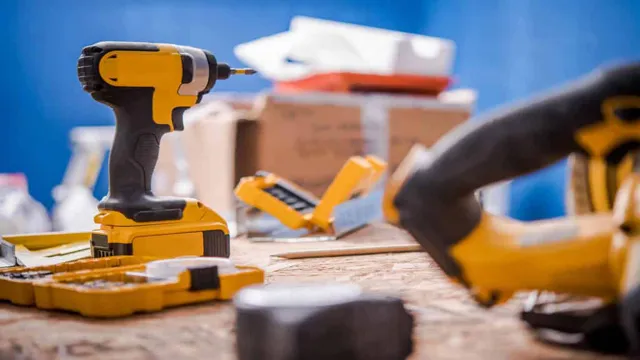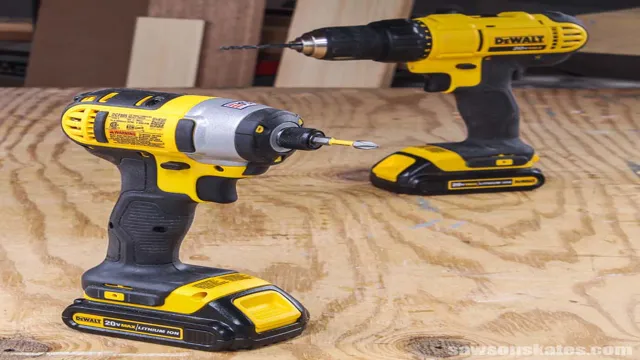Can I Use an Impact Driver as a Screwdriver? Pros, Cons and Precautions

Have you ever struggled to screw in a particular type of screw? Or spent hours turning a screwdriver and still didn’t get the job done? Well, fear not! An impact driver can make quick and easy work of tough screws, sometimes even replacing a traditional screwdriver altogether. But how exactly does an impact driver work as a screwdriver, and what do you need to know before using it in this way? In this blog post, we’re going to explore everything you need to know about using an impact driver as a screwdriver. So, grab your safety gear and let’s dive in!
Understanding Impact Drivers
If you’re wondering whether you can use an impact driver as a screwdriver, the answer is yes! Impact drivers are excellent tools for driving screws, especially those that require a bit of force to drive them deep into wood or other materials. The key difference between an impact driver and a regular drill or screwdriver is the amount of force they deliver. Impact drivers use an internal hammering mechanism that delivers bursts of power to the screw, allowing you to drive it quickly and easily without applying much pressure.
So, rather than using a regular screwdriver, using an impact driver can save you time and energy when driving screws into tough materials. Just make sure that you use the right type and size of a screwdriver bit for the job. Overall, an impact driver can be a versatile tool to have in your toolbox, making your work more efficient and hassle-free.
Impact Driver Basics
When it comes to understanding impact drivers, there are a few basics to keep in mind. Impact drivers are power tools that are specifically designed for fastening screws and bolts into tough materials like wood and metal. They’re similar to traditional cordless drills, but they have a few key differences that make them stand out.
One of the biggest differences is the way they function – impact drivers use rotational force combined with bursts of high-impact blows to drive screws and bolts quickly and efficiently. This makes them ideal for tasks that require a lot of torque and precision. Another important factor to consider is the type of bits you’ll use with your impact driver.
Most impact drivers are compatible with hexagonal bits, which come in a wide range of sizes and shapes to accommodate different types of screws and bolts. With the right combination of power and precision, the impact driver can be an essential tool for any DIY enthusiast or professional.

Advantages and Disadvantages of Using an Impact Driver as a Screwdriver
Impact Driver Impact drivers are powerful tools that are designed to provide a high degree of torque with minimal effort. They use concussive force to drive screws and other fasteners through tough materials like wood and metal. While they are primarily known for their speed and efficiency, using an impact driver as a screwdriver can have its advantages and disadvantages.
One of the primary advantages of using an impact driver as a screwdriver is its ability to handle tougher materials more effectively. It can drive screws into hard and dense woods quickly and efficiently, making it ideal for heavy-duty projects. However, one of its disadvantages is that because it is so powerful, if not used properly, it can damage the material being worked on or even snap the screw.
Additionally, it can be challenging to control an impact driver when working on smaller or more delicate projects. In conclusion, understanding the advantages and disadvantages of using an impact driver as a screwdriver will enable you to make informed decisions about which tool to use in different situations.
Can You Use an Impact Driver as a Screwdriver?
If you’re wondering whether you can use an impact driver as a screwdriver, the answer is yes. An impact driver can be used as a screwdriver, but it’s important to know the differences between the two tools and how to use them properly. An impact driver is designed for heavy-duty fastening applications and delivers an intense rotational force, making it ideal for driving in long screws and bolts.
On the other hand, a screwdriver is designed for light-duty tasks such as assembling flat-pack furniture or hanging pictures on the wall. In short, while an impact driver can be used as a screwdriver, it may not be the most efficient tool for every task. Ultimately, it depends on the task at hand and your personal preference.
However, if you’re looking for an all-in-one solution, there are multi-purpose tools that combine the functions of an impact driver and a screwdriver in one compact package.
Factors to Consider
Impact Driver as Screwdriver An impact driver is not a screwdriver. However, it can be used as a screwdriver, but there are factors that you need to consider before using it. First and foremost, you need to have the correct bit for screwing.
Most impact drivers come with a hexagonal bit holder, meaning you may need to find an adapter or have other bits that can fit the hexagonal socket. Secondly, an impact driver produces high torque, which can easily damage thinner materials such as drywall or other soft materials. To avoid damaging your project, be gentle while screwing into these materials.
Thirdly, ensure that the screws are compatible with the driver. If the screws are too long or too thick, the impact driver may not fit properly, leading to poor results or damaging the driver. In conclusion, you can use an impact driver as a screwdriver, but be cautious and remember the factors to consider.
Tips for Using an Impact Driver as a Screwdriver
Impact driver Impact drivers are powerful tools that are designed to drive screws and fasteners with minimal effort. They work by delivering sudden, high-impact torque that allows you to drive screws quickly and easily. However, using an impact driver as a screwdriver requires a bit of finesse.
One of the most important tips for using an impact driver as a screwdriver is to start slow and gradually increase the speed until you reach the desired torque. Additionally, it’s important to choose the right bit for the job, as using the wrong bit can cause damage to your impact driver or the screw. Always use a bit that fits snugly in the screw head to prevent stripping or slipping.
When using an impact driver as a screwdriver, it’s also important to use the right amount of pressure in order to avoid overtightening or under-tightening the screw. With these tips in mind, you can easily use your impact driver as a powerful screwdriver for your next project.
When to Avoid Using an Impact Driver as a Screwdriver
Impact driver as a screwdriver While an impact driver can be an excellent tool for driving screws, there are some situations where you may want to avoid using it. One such situation is when you’re working with delicate materials that require a lighter touch. Impact drivers are powerful tools that can deliver a lot of force, which can easily damage delicate materials like drywall or plaster.
In these situations, it’s better to use a regular screwdriver or a drill with a clutch that allows you to adjust the torque. Another situation where you may want to avoid using an impact driver as a screwdriver is when you’re working with a very small screw. The powerful torque of an impact driver can easily strip the threads on a small screw, rendering it useless.
In this case, it’s better to use a hand-held screwdriver or a drill with a low torque setting. This will allow you to drive the screw in without damaging it. Overall, an impact driver is a versatile and powerful tool that can be used to drive screws in a wide range of applications.
However, it’s important to understand its limitations and when it’s better to use a different tool instead. By doing so, you can ensure that your projects are completed efficiently and to the highest possible standard.
Conclusion
In summary, while an impact driver can certainly be used as a screwdriver, it would be like using a sledgehammer to hang a picture. Sure, it might get the job done, but it’s not the most efficient or practical tool for the task at hand. So, if you’re looking to save time and effort in your DIY projects, invest in a quality screwdriver set and leave the impact driver for larger scale construction jobs.
Your hands (and your sanity) will thank you.”
Pros and Cons of Using an Impact Driver as a Screwdriver
Can You Use an Impact Driver as a Screwdriver? Yes, you can. However, it is essential to keep in mind the pros and cons of using an impact driver as a screwdriver. One of the significant advantages of an impact driver is that it provides high torque, making it a perfect tool to drive long and thick screws into wood or metal.
It also has a faster driving speed compared to regular screwdrivers, making it more efficient and time-saving. However, impact drivers are not great when it comes to precision work as they lack control over the clutch and don’t provide the necessary feedback to the user. Additionally, they are quite loud and can cause fatigue if used for extended periods.
Therefore, if you are looking for a tool that can deliver the perfect balance of speed, power, and control, it’s best to use a traditional screwdriver. On the other hand, if you work with big projects that require a lot of screws, then using an impact driver can save you both time and energy.
Final Thoughts
In short, yes, you absolutely can use an impact driver as a screwdriver. However, it’s important to note that they are not interchangeable. Impact drivers are specialized power tools designed specifically for drilling and driving in tough materials like concrete, metal, and hardwoods.
They operate by delivering sudden, powerful bursts of rotational force, which makes them ideal for heavy-duty tasks that would be difficult or impossible to do by hand. On the other hand, screwdrivers are more versatile and can handle a wider range of tasks, including delicate jobs that require precision and finesse. While you may be able to use an impact driver to drive screws, it’s important to choose the right bit and adjust the settings accordingly to avoid damaging the material or the screw.
Additionally, screwdrivers are better suited for tasks like assembling furniture or installing household fixtures, where the primary goal is to turn screws quickly and easily without risking damage to the surrounding area. In conclusion, while an impact driver can be a useful addition to your toolbox, it’s important to recognize its limitations and use it appropriately for the task at hand.
FAQs
What is an impact driver and how is it different from a screwdriver?
An impact driver is a power tool that uses rotational force to drive screws and bolts while a screwdriver is a hand tool that is used to tighten or loosen screws.
Can an impact driver be used as a screwdriver?
Yes, an impact driver can be used as a screwdriver, but it is generally not recommended, as it is more powerful than a traditional screwdriver and can strip screws or cause damage to the material being screwed.
What types of screws can be used with an impact driver?
An impact driver can be used with a variety of screws including wood screws, sheet metal screws, and self-tapping screws.
Can I use an impact driver for drilling holes?
No, an impact driver is not designed to drill holes. It is specifically engineered for fastening screws and bolts.
What are the advantages of using an impact driver over a screwdriver?
The main advantages of using an impact driver over a screwdriver are speed and power. Impact drivers can fasten screws and bolts quickly and efficiently, making them a popular choice for construction projects and DIY tasks.
Can an impact driver be used with different power sources?
Yes, an impact driver can be powered by different sources, including battery, electricity, and compressed air, depending on the type and model of the tool.
Is an impact driver easy to use for beginners?
Yes, an impact driver is generally easy to use, but it is important to read the instructions manual carefully before using it and to practice on scrap materials to get used to the tool’s power and torque.



